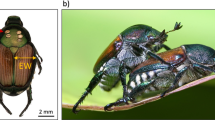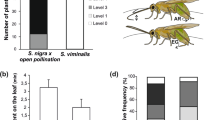Abstract
Quantitative studies on the behavioral events involved in oviposition by phytophagous insects are scant. One of these events is drumming behavior, a rapid extension of forelegs after landing on a host, which remains largely under studied. In this study, quali- and quantitative analyses of Heliconius erato phyllis (Lepidoptera: Nymphalidae) oviposition events and drumming behavior in relation to both preferred (Passiflora misera and P. suberosa) and non-preferred (P. caerulea and P. alata) hosts were performed. For the first time, drumming behavior is described by images made during the butterfly oviposition process. The same set of females was assigned to both single- and multiple-choice tests under insectary conditions, and their behaviors toward each host were recorded on video. The resulting images were analyzed frame by frame. Both frequency and duration of behavioral events related to oviposition varied on preferred vs non-preferred hosts. On preferred hosts, behaviors that were associated with egg deposition (inspecting flight, drumming and abdomen touching) were pronounced; subsequently, oviposition occurred within a few seconds. On non-preferred host plants, behaviors that did not predict oviposition (flying and resting) predominated, and oviposition on these hosts was negligible. Drumming occurred on all plants and resulted in a faster decision-making process on high-quality hosts (prompt acceptance) as well as on lethal hosts (prompt rejection) compared to the host that confers poor larval performance (delayed rejection). Thus, drumming is crucial for decision-making related in host-plant selection by H. erato phyllis, and influences other behaviors involved in the oviposition process.







Similar content being viewed by others
References
Beccaloni GW, Viloria AL, Hall SK, Robinson GS (2008) Catalogue of the hostplants of the Neotropical butterflies, vol 8. Monografias Tercer Milenio, Zaragoza
Benson WW (1978) Resource partitioning in passion vine butterflies. Evolution 32:493–518
Benson WW, Brown KS Jr, Gilbert LE (1975) Coevolution of plants and herbivores: passion flower butterflies. Evolution 29:659–680
Bernays EA (2001) Neural limitations in phytophagous insects: implications for diet breadth and evolution of host affiliation. Annu Rev Entomol 46:703–727
Bernays EA, Chapman RF (1994) Host-plant selection by phytophagous insects. Chapman and Hall, New York
Birk CD, Provensi G, Reginatto FH, Schenkel EP, Gosmann G (2005) TLC fingerprint of flavonoids and saponins from Passiflora species. J Liq Chromatogr R T 28:2285–2291
Briscoe AD, Macias-Munõz A, Kozak KM, Walters JR, Yuan F, Jamie GA, Martin SH, Dasmahapatra KK, Ferguson LC, Mallet J, Jacquin-Joly E, Jiggins CD (2013) Female behaviour drives expression and evolution of gustatory receptors in butterflies. PLoS Genet 9:e1003620. doi:10.1371/journal.pgen.1003620
Bruce TJA, Wadhams LJ, Woodcock CM (2005) Insect host location: a volatile situation. Trends Plant Sci 10:269–274
Chadha GK, Roome RE (1980) Oviposition behavior and the sensilla of the ovipositor of Chilo partellus and Spodoptera littoralis (Lepidoptera: Noctuidae). J Zool 192:169–178
Conover WJ (1999) Practical nonparametric statistics. John Wiley, New York
Corrêa CA, Irgang BE, Moreira GRP (2001) Estrutura floral das angiospermas usadas por Heliconius erato phyllis (Lepidoptera, Nymphalidae) no Rio Grande do Sul, Brasil. Iheringia Sér Zool 90:71–84
Dell’Erba R, Kaminski LA, Moreira GRP (2005) O estágio de ovo dos Heliconiini (Lepidoptera, Nymphalidae) do Rio Grande do Sul, Brasil. Iheringia, Sér Zool 95:29–46
Dethier VG (1982) Mechanism of host-plant recognition. Entomol Exp Appl 31:49–56
Dinesh AS, Venkatesha MG (2013) A quantified ethogram for oviposition behavior and oviposition preference in the hemipterophagous butterfly Spalgis epius (Westwood) (Lepidoptera: Lycaenidae). J Ethol 31:71–77
Dunlap-Pianka H, Boggs CL, Gilbert LE (1977) Ovarian dynamics in heliconiine butterflies: programmed senescence versus eternal youth. Science 197:487–490
Feeny P, Rosenberry L, Carter M (1983) Chemical aspects of oviposition behavior in butterflies. In: Ahmad S (ed) Herbivorous insects: host-seeking behavior and mechanisms. Academic Press, New York, pp 27–76
Ferro VG (1998) Criação de Heliconius erato phyllis (Fabricius) (Lepidoptera, Nymphalidae) em condições semi-naturais. Senior Thesis, Universidade Federal do Rio Grande do Sul, Brasil
Fox RM (1966) Forelegs of butterflies I: introduction: chemoreception. J Res Lepidop 5:1–12
Ganehiarachchi GASM, Harris M (2009) Ovipositing females of a short-lived gall midge take time to assess grass seed heads. Physiol Entomol 34:119–128
Gershenzon J, Croteau R (1991) Terpenoids. In: Rosenthal GA, Berenbaum, MR (eds) Herbivores: their interactions with secondary plant metabolites, 2nd edn. Academic Press, San Diego, pp 165–219
Gilbert LE (1972) Pollen feeding and the reproductive biology of Heliconius butterflies. P Nat Acad Sci USA 69:1403–1407
Gilbert LE (1975) Ecological consequences of a coevolved mutualism between butterflies and plants. In: Gilbert LE, Raven PH (eds) Coevolution of animals and plants, eds edn. University of Texas Press, Austin, pp. 210–240
Gripenberg S, Mayhew PJ, Parnell M, Roslin T (2010) A meta-analysis of preference-performance relationships in phytophagous insects. Ecol Lett 13:383–393
Haribal M, Renwick JAA (1998) Differential postalightment oviposition behavior of monarch butterflies on Asclepias species. J Insect Behav 11:507–538
Harris MO, Foster SP (1995) Behavior and integration. In: Cardé RT, Bell WJ (eds) Chemical ecology of insects 2. Chapman and Hall, New York, pp. 3–46
Harris MO, Miller JR (1991) Quantitative analysis of ovipositional behavior: effects of a host-plant chemical on the onion fly (Diptera: Anthomyiidae). J Insect Behav 4:773–792
Hartmann T (1991) Alkaloids. In: Rosenthal GA, Berenbaum MR (eds) Herbivores: their interactions with secondary plant metabolites, 2nd edn. Academic Press, San Diego, pp 79–121
Ichinosé T, Honda H (1978) Ovipositional behavior of Papilio protenor demetrius Cramer and the factors involved in its host plants. Appl Entomol Zool 13:103–114
Ilse D (1937) New observations on responses to colours in egg-laying butterflies. Nature 140:544–545
Kerpel SM, Moreira GRP (2005) Absence of learning and local specialization on host plant selection by Heliconius erato. J Insect Behav 18:433–452
Ma WC, Schoonhoven LM (1973) Tarsal contact chemosensory hairs of the large white butterfly, Pieris brassicae, and their possible role in oviposition behavior. Entomol Exp Appl 16:343–357
Martin P, Bateson P (2007) Measuring behavior: an introductory guide. Cambridge University Press, Cambridge
Menna-Barreto Y, Araújo AM (1985) Evidence for host plant preferences in Heliconius erato phyllis from southern Brazil (Nymphalidae). J Res Lepidop 24:41–46
Motulsky H (1999) Analyzing data with GraphPad prism software. GraphPad Software, San Diego
Mugrabi-Oliveira E, Moreira GRP (1996a) Conspecific mimics and low host plant availability reduce egg laying by Heliconius erato phyllis (Fabricius) (Lepidoptera: Nymphalidae). Rev Bras Zool 13:929–937
Mugrabi-Oliveira E, Moreira GRP (1996b) Size of and damage on shoots of Passiflora suberosa (Passifloraceae) influence oviposition site selection of Heliconius erato phyllis (Fabricius) (Lepidoptera: Nymphalidae). Rev Bras Zool 13:939–953
Myers J (1969) Distribution of foodplant chemoreceptors on the female Florida queen butterfly, Danaus gilippus berenice (Nymphalidae). J Lepidop Soc 23:196–198
Ney-Nifle M, Keasar T, Shmida A (2001) Location and color learning in bumblebees in a two-phase conditioning experiment. J Insect Behav 14:697–711
Nishida R (2005) Chemosensory basis of host recognition in butterflies – multi-component system of oviposition stimulants and deterrents. Chem Sens 30:293–294
Périco E (1995) Interação entre quatro espécies de Heliconiini (Lepidoptera: Nymphalidae) e suas plantas hospedeiras (Passifloraceae) em uma floresta secundária do Rio Grande do Sul, Brasil. Biociências 3:3–18
Périco E, Araújo AM (1991) Suitability of host plants (Passifloraceae) and their acceptableness by Heliconius erato and Dryas iulia (Lepidoptera; Nymphalidae). Evol Biol 5:59–74
Prokopy RJ, Owens ED (1983) Visual detection of plants by herbivorous insects. Annu Rev Entomol 28:337–364
Ramaswamy SB (1988) Host finding by moths: sensory modalities and behaviors. J Insect Physiol 34:235–249
Ramaswamy SB, Ma WK, Baker GT (1987) Sensory cues and receptors for oviposition by Heliothis virescens. Entomol Exp Appl 43:159–168
Renou M (1983) Les récepteurs gustatifs du tarse antérieur de la femelle d’Heliconius charitonius (Lep.:Heliconiidae). Ann Soc Entomol Fr 19:101–106
Renwick JAA (1989) Chemical ecology of oviposition in phytophagous insects. Experientia 45:223–228
Renwick JAA, Chew FS (1994) Oviposition behavior in Lepidoptera. Annu Rev Entomol 39:377–400
Rodrigues D, Moreira GRP (2002) Geographical variation in larval host-plant use by Heliconius erato (Lepidoptera: Nymphalidae) and consequences for adult life history. Braz J Biol 62:321–332
Roessingh P, Städler E, Schöni R, Feeny P (1991) Tarsal contact chemoreceptors of the black swallowtail butterfly Papilio polyxenes: responses to phytochemicals from host- and non-host plants. Physiol Entomol 16:485–495
Rosser N, Phillimore AB, Huertas B, Willmott KR, Mallet J (2012) Testing historical explanations for gradients in species richness in heliconiine butterflies of tropical America. Biol J Linn Soc 105:479–497
Silva DS (2015) Descrição, função e evolução do tarsos protorácicos em heliconíneos (Lepidoptera, Nymphalidae). Unpublished Ph.D. Dissertation, Universidade Federal do Rio Grande do Sul
Silva AK, Gonçalves GL, Moreira GRP (2014) Larval feeding choices in heliconians: induced preferences are not constrained by performance and host plant phylogeny. Anim Behav 89:155–162
Singer MC (1986) The definition and measurement of oviposition preference in plant-feeding insects. In: Miller JR, Miller TA (eds) Insect-plant interactions, eds edn. Springer-Verlag, New York, pp. 65–94
Swihart SL (1967) Hearing in butterflies (Nymphalidae: Heliconius, Ageronia). J Insect Physiol 13:469–476
Ulmer T, MacDougal JM (2004) Passiflora: passionflowers of the world. Timber Press, Cambridge
Wolfe JM, Oliver JC, Monteiro A (2011) Evolutionary reduction of the first thoracic limb in butterflies. J Insect Sci 11:66
Zar JH (1999) Biostatistical analysis. Prentice Hall, Upper Saddle River
Acknowledgments
We are grateful to Carolina Millan, Daniel Basílio, Eduardo Gehl, Fernando Luz, Bruna Menezes Ramos and Denis Santos Silva for field and laboratory assistance. We also thank Daniel Basílio for his great help in designing behavioral flowcharts and exchanging ideas on the manuscript. Bruna Ramos provided support with statistical analyses. Marion Harris, Danessa S. Boligon, Vera L. Gaiesky, Luiz A. Campos, Janet W. Reid and three anonymous reviewers provided valuable comments on the early drafts of the manuscript. This study was funded by CAPES (SCT) and CNPq Foundations (grants 480264/2010-4 to DR and 309676/2011-8 to GRPM).
Author information
Authors and Affiliations
Corresponding author
Additional information
Submitted to: Journal of Insect Behavior
Electronic supplementary material
ESM 1
Online resource 1 Video showing a female of Heliconius erato phyllis performing inspecting flight on Passiflora misera (WMV 6896 kb)
ESM 2
Online resource 2 Video showing a female of Heliconius erato phyllis performing drumming on Passiflora suberosa (WMV 2704 kb)
ESM 3
Online resource 3 Video showing a female of Heliconius erato phyllis performing abdomen touching on Passiflora suberosa (WMV 3595 kb)
Rights and permissions
About this article
Cite this article
Thiele, S.C., Rodrigues, D. & Moreira, G.R. Oviposition in Heliconius erato (Lepidoptera, Nymphalidae): how Essential Is Drumming Behavior for Host-Plant Selection?. J Insect Behav 29, 283–300 (2016). https://doi.org/10.1007/s10905-016-9559-z
Revised:
Accepted:
Published:
Issue Date:
DOI: https://doi.org/10.1007/s10905-016-9559-z




